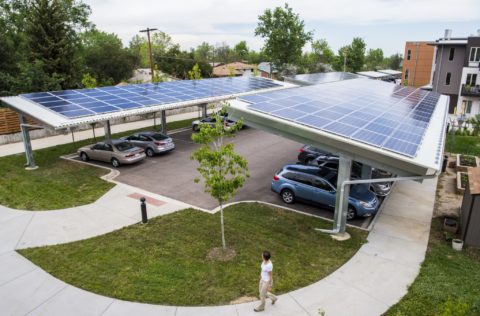
A future filled with electric cars, renewable energy, and efficient buildings will require a modernized grid. As utilities begin to recognize the financial opportunities of this essential but expensive undertaking, a new report highlights the untapped potential of green bonds.
Recently, EF became interested in what might happen if U.S. utilities utilized green bonds aggressively to fund the clean, resilient new infrastructure we need. We posed the question to our colleagues at Boston University’s Institute for Sustainable Energy (ISE), and the results are compelling.The report, Assessing the Potential for U.S. Utility Green Bonds, was funded by the Energy Foundation and emerged from careful research and engagement with finance leaders.
Even with a conservative methodology, the authors find the electric industry could raise between $250 to $500 billion with green bonds—far more than the approximately $26 billion issued in 2017—without disrupting a utility’s credit rating or increasing the cost of capital.
First issued by the European Development Bank in 2007, green bonds allot investments toward projects such as renewable energy, energy efficiency, and pollution control. Since their debut, green bonds have increased globally at 60 percent annually, and are now issued regularly to a willing marketplace by governments, banks, and corporations. This is a catalytic new source of climate-aligned financing, creating a transparent means for both institutional and everyday investors to support the climate transition.
By using debt instead of equity, which typically demands twice as much in returns, utilities that use green bonds can provide essential energy services at a lower cost to consumers. These cost savings matter a great deal to the clean energy future, since broad consumer uptake requires electricity to be cheaper than the fossil alternative. And if we design the process thoughtfully, these bonds can be available for purchase by the very communities in which sustainable infrastructure is being deployed, helping to build inclusionary economics into climate strategies from inception.
Several utilities already have issued green bonds to fund important clean energy projects. Among others, the ISE report highlights Southern Power’s issuance of green bonds to fund wind and solar facilities serving customers across the U.S., while Michigan’s DTE Energy has used the tool for both renewables and strengthening energy efficiency programs.
In places like California, where protection from climate disruptions must be pursued in tandem with climate solutions for the long run, green bonds can finance both sets of urgent needs. Last year, California became the first state to sign the Green Bond Pledge, modeling a way governments can lead adoption of this useful tool.
Every path toward action on the climate crisis requires massive expansion of clean electricity. This means the nation’s energy utilities will play a key role in our climate-safe future. To be sure, this is a role that is likely to be quite different from what utilities do today. But however they may change, there is one key role utilities should continue to play: They can tap the capital markets more cheaply and at a greater scale than almost any other actor in our economy.
We need utilities to play this role, and in the course of raising and investing money in the technologies we need to avoid climate disaster, energy utilities can reestablish their social license and lay new foundations of trust within the communities they serve. Utilities have often been perceived as monoliths that act in opposition to the public interest. Green bonds can help them become newly aligned private partners in addressing the defining crisis of our time.